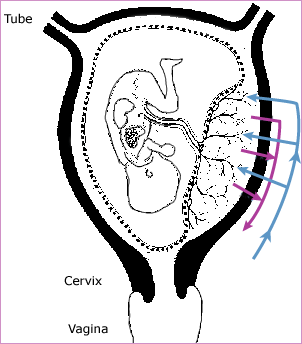 |

“Group B Strep can definitely invade the placental membranes”
Dr. Sharon Hillier, University of Pittsburgh School of Medicine
Since its emergence in the 1970's, group B streptococcal (GBS) disease has been the leading bacterial infection associated with illness and death among newborns in the United States....stillbirths and premature delivery also have been attributed to GBS." CDC MMWR May 31, 1996/Vol. 45/No. RR-7
"Microorganisms in the vagina can be transported into the uterus by digital examination and by uterine contractions. Perineal and vaginal ultrasound examination offer an alternative to digital examination, especially before the onset of labor." James A. McGregor, MD.
Many investigators have graded the inflammatory infiltration (e.g., Thiery et al., 1970; Naeye et al., 1983) so as to perhaps correlate it with clinical findings (e.g., rupture of membranes and maternal fever). We have found this practice to be impractical for several reasons. For instance, there are severe prenatal infections with some types of organism, in particular the group B streptococcus, that elicit little placental inflammatory reaction but can produce devastating disease in the newborn. It is also likely that different organisms have differing ability to penetrate the membranes. This point was shown experimentally by Galask et al. (1984), who exposed membranes to bacterial cultures. They found that group B streptococci penetrated membranes more readily than did coliform bacilli and gonococci. We believe that the intensity of inflammation is more closely related to the nature of the organism than to the chronicity of the infection. It seems also difficult to estimate how long the infection has been active. This uncertainty has hindered acceptance of the opinion that membrane rupture follows membranitis, rather than causes it (see Naeyc & Peters, 1980). The prevailing view certainly is that membranes rupture first, followed by amnionitis.
|
Infections with group B streptococci are now important and frequent complications of the perinatal period, and we now differentiate between early and lateonset neonatal infections because of their significant differences in outcome. This streptococcus is recognized to be one of the most virulent organisms during the perinatal period. Sepsis, pneumonia, and meningitis are common sequelae of this infection (Baker, 1977), and the organism has emerged as the number two cause of neonatal meningitis (Anonymous, 1977a). Prematurity and premature rupture of membranes are strongly cor related with group B streptococcal infections. The diagnosis is often difficult unless it is actively pursued. Occult streptococcal infection is an important cause of fetal asphyxia, and stillbirths frequently occur with unruptured membranes (Naeye & Peters, 1978; Peevy A. Chalhub, 1983).
From "Pathology of the Human Placenta, Third Edition", Kurt Benirschke and Peter Kauffman.
|
 |
|
 |
|
 |